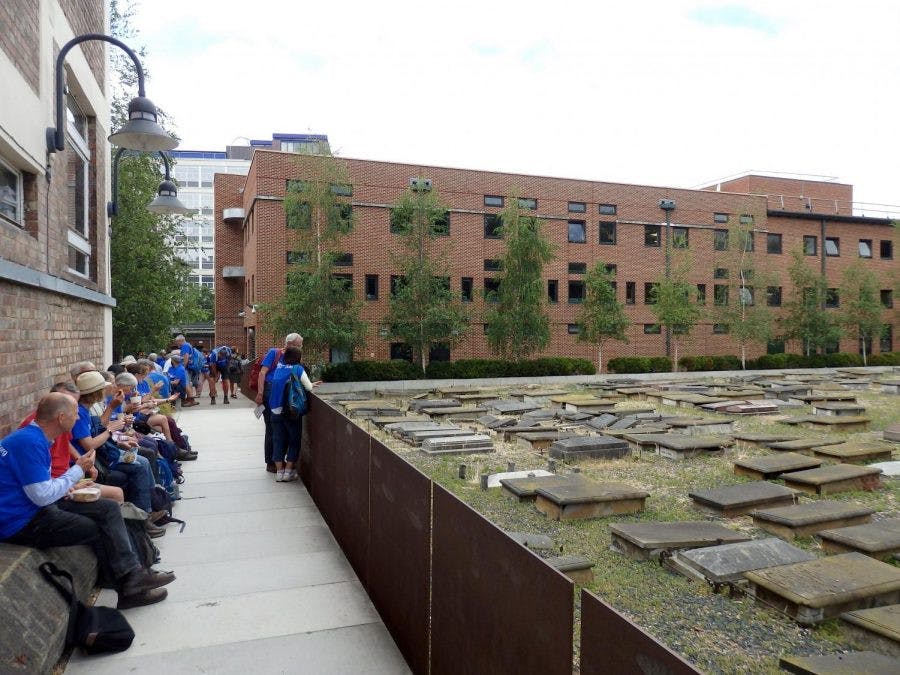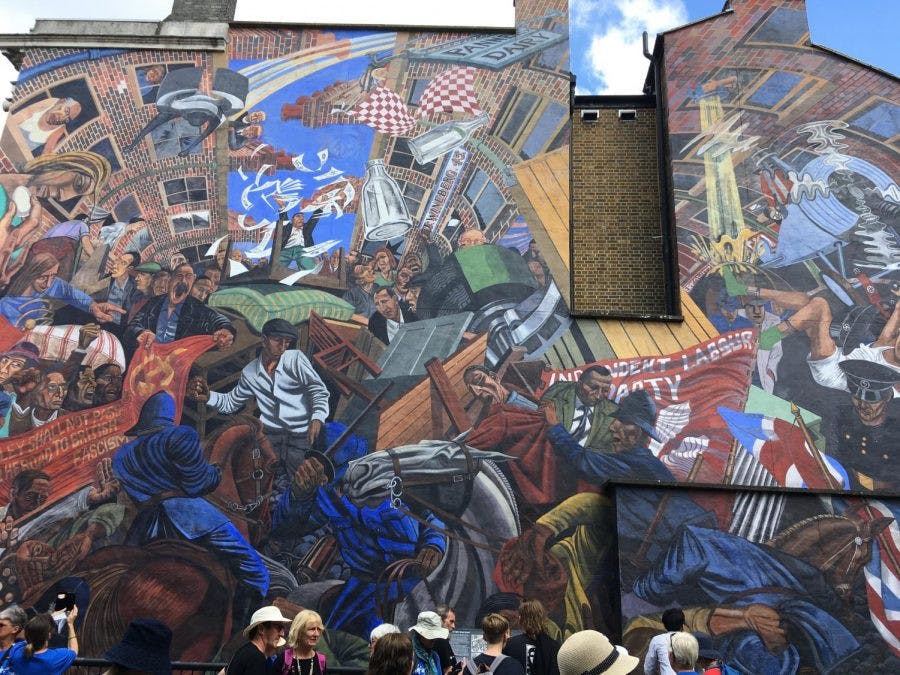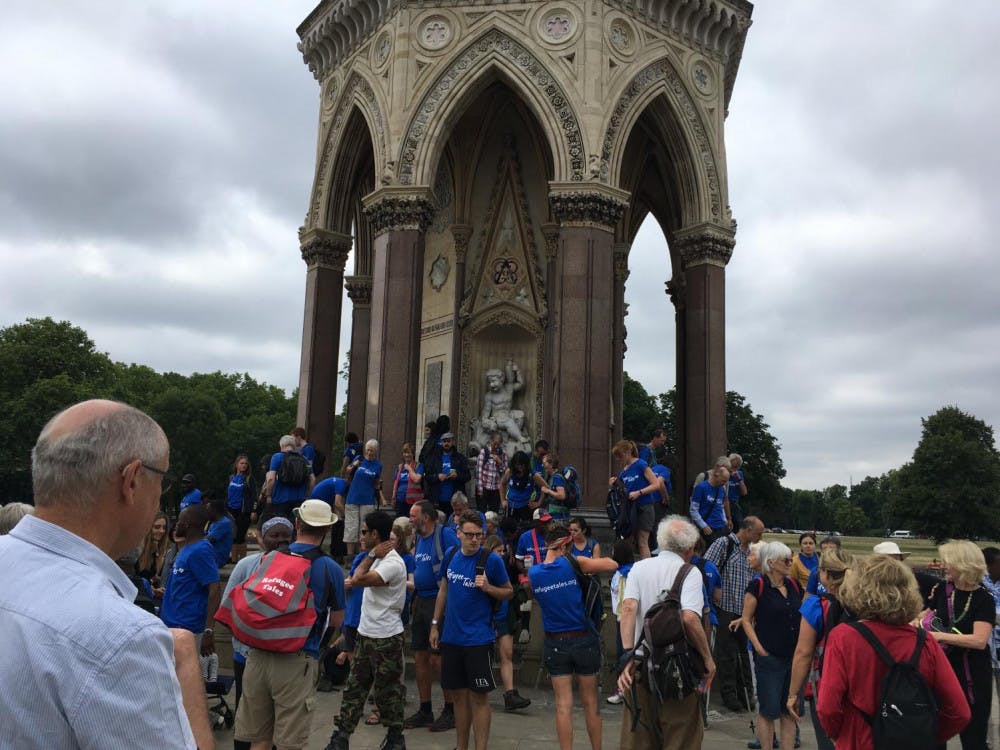On July 11, 2018, I joined the London-based group Refugee Tales on the fifth day of their pilgrimage through London’s busy streets, neighborhoods, parks and commercial throughways in an act of protest and in solidarity with refugees and asylum-seekers in the United Kingdom. Inspired by Chaucer’s Canterbury Tales, Refugee Tales stops each night to commune with locals, and listens to stories of refugees by established writers.
Refugee Tales calls for an end to the policy of indefinite detention and the creation of humane policies for migrants fleeing their homelands.
As we walked in solidarity with migrants in London, many across the Atlantic were protesting the inhumane practice of separating children from their parents as they crossed the Mexican border. Closer to Vermont, Immigration and Customs Enforcement arrested 25-year old A (not his full name), a migrant farmer from Addison county, and was holding him at a detention center in New Hampshire, separating him from his family.
These policies are reminiscent of colonial and post-colonial abuses endured by non-white migrants for generations. I think of my own family’s history of migration across the British, Portuguese and Spanish empires, and through four Caribbean countries before we arrived in the United States.
Europeans and North Americans have also experienced migration, some with more privileges than others. Consider the U.S. southerners and the Quebecois migrants who fled to Brazil in the nineteenth century, the intellectuals and artists who sought refuge in Paris, or the thousands of Irish and Jews who left Europe to build new homes in places from Cuba to China. Stories of migration have shaped the lives of many at the college and in the communities where we live.
Today British authorities detain tens of thousands of people in eleven ‘immigration removal centers,’ at a cost of over a million pounds per year. While the United States does not practice indefinite detention as a principle, it directs its resources towards immediate deportation. Both policies are inhumane.

Halfway through our pilgrimage, we stop at Queen Mary University, where state-of-the-art buildings surround the old Sephardic Jewish cemetery. Cemeteries and burial sites become important signposts of migration and memory even as modernization destroys the cultural history of the less powerful. At Middlebury, the Christianization and burial of Egyptian prince Amun-Her Khepeshef in the graveyard next to the Rohatyn Centre for Global Affairs exemplifies these tensions.
Migration is connected to the histories of slavery, racism and genocide. It is also connected to scientific innovation and the quest for equality. The Vermont Folklife Center in Middlebury and the Rokeby Museum in Ferrisburg document many of these contradictions.
In London, I walk alongside Amazir (not his real name), one of the ten million migrants who have no nationality. He was caught between two countries that refused to recognize him but gladly wanted to conscript him into their armies. Hannah Arendt describes his conundrum in “The Perplexities of the Rights of Man.”
The work of scholar Gloria Anzaldúa reminds us that borders have often crossed people rather than the other way around. Later on our walk in London I meet AJ, a university student studying social work with his own complicated story of crossing borders and detention. AJ, who may have been born in India or Nepal, is still trying to understand his story after having lost his parents.

When we get to Whitechapel, we stop at the Cable Street Mural, commemorating the October 1926 demonstrations against fascists who terrorized the migrant and Jewish residents. Confrontations like the one in Charlottesville are not new in the Atlantic world. The mural documents history, but the astute artists have also found a way to embrace the demographic shifts in the neighborhoods by including South Asian subjects in the mural.
As we leave the park, I meet Patience Agbabi, British Poet Laureate of Canterbury. Agbabi, a child of Nigerian parents, has published the ‘tale’ of Samia (not her real name), a Coptic woman who fled Egypt for the United Kingdom. We talk about poetry’s ability to document suffering and portray the complex truth of Samia’s story. Later that day, I will hear other stories read by the actress Vanessa Redgrave and Neel Mukherjee, author of The Lives of Others.
The sharing of stories is part of a long tradition of healing and activism. Walking with migrants and listening to their stories help us notice the migrant signposts in our surroundings. It also creates a new awareness that can lead to a shift in consciousness. The goals of Refugee Tales align with the ambitions of many groups calling for more humane migration policies.
Today, I look at landscapes and architecture differently. I consciously notice the signposts shaped or touched by migrants globally and locally.
According to the American Immigrant Council, migrants make up 4.5% of Vermont’s population. Historically, these numbers have included Italian and Irish migrants who worked in the mills and helped build St. Mary’s Catholic Church. Towns and businesses with Anglicized French names and the sound of Bosnian in the aisles of Hannaford are potential fragments of the migrant tales waiting to be uncovered.
And then there are the environmental and cultural ironies: The Mexican dairy farmers and Jamaican apple pickers who travel thousands of miles to help produce goods “Made in Vermont.” Migrants have also shaped Middlebury’s curriculum. They have helped prepare our food and take care of our grounds.
In the current climate it is important to recognize the stories and signposts of migrants and refugees. Refugee Tales encourages us to listen, to notice, to walk, and to act to transform our politics. It is a beautiful model for both sides of the Atlantic.
David Herd and Anna Pincus will bring Refugee Tales to the Abernathy Room in Axinn on October 15 (4:30-6:00pm). They will discuss Refugee Tales and read several migrant stories written by established writers in the United Kingdom. Please join us for a cross-Atlantic discussion. Weather permitting, we will take a short walk of solidarity with migrants, refugees and asylum seekers from Proctor Hall terrace through the cemetery to the Centre for the Arts beginning at 12 noon.
Refugee Tales and the Signposts of Migration: A Cross-Atlantic Perspective

The Refugee Tales’ pilgrimage stops at the Sephardic Jewish cemetery at Queen Mary’s University. COURTESY PHOTO
The Cable Street Mural documents 19th century injustices against migrant and Jewish residents of Whitechapel. COURTESY PHOTO
Comments



